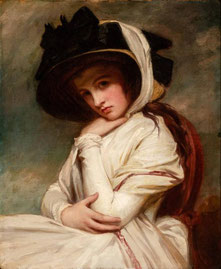Lady Emma Hamilton and her Attitudes

Emma Hamilton was born Amy Lyon in 1765 and was raised for much of her early life by a single mother in deprived circumstances in Cheshire, England. In a
spectacular rise fuelled by her outstanding beauty but much more her theatrical talent, charisma and great talent for languages and conversation, Emma went on to have a massive influence on
European visual culture.
As a teenager, this was yet still far out of sight. As a teenager, she went to London where she worked as a domestic servant, shop employee, and later a childminder. Preyed on by her master, she left the situation and had to fend for herself entirely. For a brief spell, she performed the role of "Goddess of Health" in scanty dress in the travelling show of London a quack doctor where she gained first performance experience. Around this time she changed her name to Emma.
Her beauty attracted suitors and she became mistress to several wealthy young men when still a teenager. The longest of these was with Charles Francis Greville.
This relationship is by modern standards problematic on several levels as her suitor was an adult and she a minor, and there was a notable difference in power, money and social standing.
Nonetheless, this situation allowed Emma to make contacts in better society, gain an education (as Charles Greville paid for private tuition and books) and it eventually made her acquainted with
the famous painter George Romney. He marvelled at her classical beauty and made many paintings of her for which she sat as different mythological, historical and religious characters. In this
setting Emma had the opportunity to really train and nuture her artistic talent for performance and for creating visual images. She was model for many of Romney's best paintings which show her as
bacchante, Circe, Cassandra or as the personification of nature. Her versatile play of features and her skill at using props and draping cloths around her would come in very handy in her later
life.
Charles Greville sank into considerable debt and under the pretence of giving Emma a nice holiday to Italy, he essentially sold her to his uncle Lord
Hamilton, the English Ambassador in Naples in exchange for him settling his debts. Ignoring her low social rank, her turbulent past life and the great age difference he eventually married her,
making her Lady Emma Hamilton. Emma had smartly categorically refused becoming a mistress again and would only settle for marriage. William had so much respect for his new wife's talents that he
had her presented at Court in Naples. There, a strong friendship emerged between the lonely Queen Maria Carolina and Emma. Still, there were voices murmuring gossip about the upstart "Emma Hart".
Lady Hamilton adored great parties and social events where she was the centre of attention. Her open personality was extremely well suited to be the wife of an Ambassador and receive all the
British travellers on their Grand Tours of the continent, show them around Naples, assist them in difficulty and generally to establish the Naples Consulate as a centre of splendid
culture.
During this time, she invented a "new art": the Attitudes. Combining a theatrical performance with the fashion for tableaux vivants (frozen images composed of
groups of actors who keep still to perform 'living paintings' of famous scenes). This was an era of print media, and also an era of great sensibility and romanticism, and her tableaux united
both.
Emma started by performing impressions of famous antique characters, saints and historical figures. She stood alone in a part of the room, watched by her audience. There she quickly changed her posture, expression and dress. Using only a Cashmere shawl, an antique vase or a pillar from her husbands great antiques collection and sometimes a few other performers, requisites and statists she could portrait a celebrating bacchante but in the next moment change into repentant Maria Magdalene, or altering from a grieving Queen Dido to an image of a doting ancient Roman mother. She held each posture/each character for a few seconds or minutes. Her mimic was capable of every emotion from exuberance over thoughtfulness to rage or mourning. With one fluent movement, it is said, she could change her shawl into a turban or gracefully unwrap it to form a cloak. Those admired performances of her Attitudes brought her international fame. Johann Wolfgang von Goethe, for example, was struck with her when he saw her perform in 1787. Prints of her performances circulated across all of Europe and caused a stylistic storm. Thus, an art form inspired by print went full circle to be represented in print once again.
At one party, Emma's fate changed again as she met the famous Admiral Horatio Nelson. The unlikely couple of the still very young actor and ambassadress Emma and
the war-damaged battle hero Horatio fell in love. The ensuing affair became public but this did not bother either Nelson or the ageing Lord Hamilton who tolerated the affair. Emma's and Nelson's
daughter, Horatia Nelson, was born in 1801. They lived in a menage-à-trois until the death of Lord Hamilton in 1803. But Emma's happy star was sinking; Nelson tragically died in the Battle of
Trafalgar in October, 1805. He was wounded fatally in action but yet heard the great victory over France he had achieved. He left a desperate Emma behind. His last dying request that Emma and
Horatia would be assisted financially in recompense for his great achievements for the United Kingdom was not
honoured.
Emma, too used to the lavish lifestyle and unable to budget sank into destitution. Consequently, she soon fell into debts and died in great deprivation in Calais, France, in 1815 to where she had fled to escape her debtors.
© Epochs of Fashion
